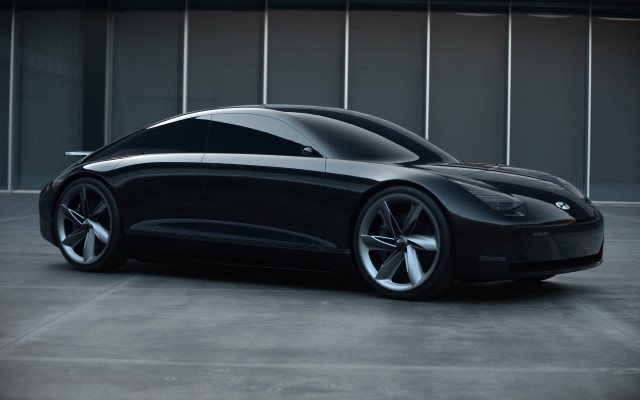The Hyundai Prophecy shows the way forward for the brand not just in terms of an EV future but also the design and equipment that will form a part of the experience.

The Hyundai Prophecy speaks of the company’s new design language, “Sensual Sportiness”, expanding on the 45 Concept EV shown earlier that, and I quote, “stripped away complexity in favour of clean lines and minimalist structures.” While that may seem, and look, cool, there’s no denying the Prophecy Concept looks like a swooping four-door coupé form that will aim to rival the best Europe has to offer. Hyundai say their designers have achieved the “ultimate automotive form”. Well, they have put a lot into it.
Firstly, the design of the Hyundai Prophecy is extremely aerodynamic, with propeller shapes embedded in the wheels that help draw air in. Transparent acrylic material gives a view of functional components underneath, and is integrated in the spoiler, headlamps and camera monitoring system. Pixel lamp-lights are used in the headlamps, tail-lamps and spoiler to point to the abundant energy in the battery cells.
The interior in the Hyundai Prophecy underlines the advantages of using the stretched cabin of an EV platform, and the autonomous driving angle sees the use of a joysticks instead of a steering wheel. Hyundai have created an environment where eco-friendly design and material selection combine to demonstrate their vision for EVs of the future. External intakes placed at the bottom of the side doors allow air to circulate through Clean Air Technology, providing a steady stream of purified air inside the vehicle. The flow of clean air over the interior’s wool-based felt carpet is inspired by the flow of water in nature. The interior’s colours and materials compel passengers to take time to decompress, aided by low intensity ambient lighting, while gently soothing modulated colours encourage rest and relaxation. Furthermore, the treated air is circulated back out into the atmosphere as clean air.
Hyundai are set to expand their product line-up to include 44 electrified vehicles, and alone plan to invest almost € 50 billion (Rs 4 lakh crore) for research and development into future technologies by 2025. The expectation is to sell more than 670,000 battery and fuel cell electric vehicles annually by this time, and to be positioned among the top three EV providers globally. In Europe, more than 75 per cent of the line-up will be electrified by the end of 2020, and the company hope to supply almost 80,000 zero-emission vehicles to European buyers this year; for whatever’s left of it.
SangYup Lee, Head of Hyundai Global Design Center, said, “We have brought to life yet another icon that establishes a new standard for the EV segment as well as pushing Hyundai’s design vision to even broader horizons. A part of that expansion is what we call Optimistic Futurism, a design concept embodied by ‘Prophecy’. With ‘Optimistic Futurism’, our aim is to forge an emotional connection between humans and automobiles.”




















Leave a Reply